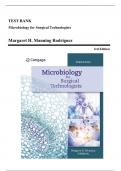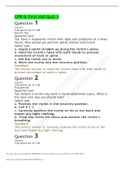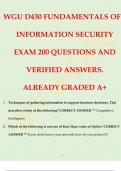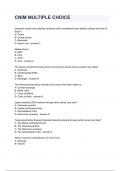TEST BANK
Microbiology for Surgical Technologists
Margaret H. Manning Rodriguez
3rd Edition
,Table of Contents
Ch 01 Introduction to Microbiology 1
Ch 02 The Science of Microbiology 13
Ch 03 The Microbiology Laboratory 25
Ch 04 The Prokaryotes 37
Ch 05 The Eukaryotes 49
Ch 06 Microbial Viability and Growth 61
Ch 07 Microbial Genetics and Mutations 73
Ch 08 The Empire of Viruses 85
Ch 09 Microbial Disease Transmission 97
Ch 10 Parasites and Vectors 109
Ch 11 Mycology 121
Ch 12 Gram Positive Cocci 133
Ch 13 Gram Positive Bacilli 145
Ch 14 Actinobacteria 157
Ch 15 Gram Negative Cocci and Spirochetes 169
Ch 16 Gram Negative Bacilli and Coccobacilli 182
Ch 17 Diseases of the Circulatory and Central Nervous Systems 195
Ch 18 Diseases of the Skin and the Internal Tissues 207
Ch 19 Diseases of the Gastrointestinal and Genitourinary Systems 219
Ch 20 Diseases of the Eyes Ears and Respiratory Systems 231
Ch 21 Control of Microbial Growth 243
Ch 22 Emerging Recurring and Reappearing Diseases 255
,______________________________________________________________________________________________
Test Bank - Microbiology for Surgical Technologists, 3rd Edition (Rodriguez, 2023)
Ch 01: Introduction to Microbiology
Multiple Choice
1. Who was the first pioneer in Microbiology to use the term “cell” to describe the small, honeycomb-like spaces seen in
cork?
a. Girolamo Fracastoro
b. Robert Hooke
c. Edward Jenner
d. Ignaz Semmelweis
ANSWER: b
FEEDBACK: a.
b. Robert Hooke designed telescopes and later a compound microscope in the
mid-1600s and published “Micrographia” where he was the first to use the term
“cell” to describe the spaces he saw in cork when magnified. This was the
beginning of cell theory.
c.
d.
DIFFICULTY: Low
LEARNING OBJECTIVES: 1.3 - Discuss significant historical contributions from pioneers in microbiology.
KEYWORDS: Remember
2. Which researcher in the Golden Age of Microbiology was commissioned by French Emperor Napoleon III to create a
scientific study on spoilage of beer and wine?
a. Robert Koch
b. Joseph Lister
c. Louis Pasteur
d. Francesco Redi
ANSWER: c
FEEDBACK: a.
b.
c. Louis Pasteur was a renowned scientist in France in the late 1800s who
worked to disprove the long- held belief in abiogenesis and caught the attention
of Emperor Napoleon who wanted him to find a way to stop the spoilage of
beer and wine, turning it into vinegar. From this, he created the technique of
pasteurization.
d.
DIFFICULTY: Low
LEARNING OBJECTIVES: 1.3 - Discuss significant historical contributions from pioneers in microbiology.
KEYWORDS: Remember
3. Who was the first person to identify the corona virus using electron microscopy in 1964?
a. June Almeida
b. Elizabeth Bugie
c. Ruth Ella Moore
d. Antonie van Leeuwenhoek
ANSWER: a
FEEDBACK: a. June Almeida was a talented lab technician who, despite not having earned an
_____________________________________________________________________________________________
1|Page
,______________________________________________________________________________________________
Test Bank - Microbiology for Surgical Technologists, 3rd Edition (Rodriguez, 2023)
advanced degree, was able to develop a method of using antibodies to isolate
viruses with the use of the electron microscope and was the first to describe
what would become the very well recognized coronavirus shape.
b.
c.
d.
DIFFICULTY: Low
LEARNING OBJECTIVES: 1.4 - Relate notable discoveries and events of the twentieth century from the
historic timeline to current, twenty-first century public health concerns.
KEYWORDS: Remember
4. Which agent was sent in letters through the U.S. Postal Service to media outlets as an act of bioterrorism in 2001?
a. Anthrax
b. Cholera
c. Ebola
d. Smallpox
ANSWER: a
FEEDBACK: a. Letters laced with anthrax were mailed to the New York Post and NBC, and
later to several US Congressmen. Office workers were sickened, and several
US postal workers died from inhalation anthrax. A governmental scientist was
eventually charged with the crimes.
b.
c.
d.
DIFFICULTY: Low
LEARNING OBJECTIVES: 1.4 - Relate notable discoveries and events of the twentieth century from the
historic timeline to current, twenty-first century public health concerns.
KEYWORDS: Remember
5. The Healthcare Infection Control Practices Advisory Committee (HICPAC) develops guidelines for healthcare workers
to prevent disease transmission in the workplace as a special section of which governmental agency?
a. ACA – Affordable Care Act
b. CDC – Centers for Disease Control and Prevention
c. EPA – Environmental Protection Agency
d. FDA – Food and Drug Administration
ANSWER: b
FEEDBACK: a.
b. A special section within the Centers for Disease Control and Prevention (CDC)
is the Healthcare Infection Control Practices Advisory Committee (HICPAC), a
group charged with making and reviewing guidelines, that are then used for
advising the CDC, the US Secretary of Health and Human Services (HHS), and
other agencies regarding a broad scope of public health issues.
c.
d.
DIFFICULTY: Low
LEARNING OBJECTIVES: 1.2 - Discuss the responsibilities of surgical technologists and other sterile surgical
team members in prevention of disease transmission.
KEYWORDS: Remember
_____________________________________________________________________________________________
2|Page
,______________________________________________________________________________________________
Test Bank - Microbiology for Surgical Technologists, 3rd Edition (Rodriguez, 2023)
6. The Schick test is a skin test developed in 1913 to demonstrate immunity or susceptibility to which disease?
a. Diphtheria
b. Polio
c. Smallpox
d. Yellow fever
ANSWER: a
FEEDBACK: a. Bela Schick produced a widely used skin test that showed whether someone
was susceptible or immune to diphtheria and named for her. A subsequent
massive immunization program for those who tested positive resulted in a
dramatic decrease in diphtheria cases.
b.
c.
d.
DIFFICULTY: Low
LEARNING OBJECTIVES: 1.4 - Relate notable discoveries and events of the twentieth century from the
historic timeline to current, twenty-first century public health concerns.
KEYWORDS: Remember
7. What is the term that describes an early belief that living things spontaneously arise from non-living materials?
a. Cell theory
b. Germ theory
c. Abiogenesis
d. Pasteurization
ANSWER: c
FEEDBACK: a.
b.
c. Most scientists believed in the theory of spontaneous generation referred to as
abiogenesis, that claimed that life could spontaneously arise from non-living
material. It held up until the second half of the nineteenth century.
d.
DIFFICULTY: Low
LEARNING OBJECTIVES: 1.5 - Explain how the theories of spontaneous generation and abiogenesis were
disproved and the impact on the work of future researchers.
KEYWORDS: Remember
8. Antonie van Leeuwenhoek used which term to describe the tiny organisms he saw with a single-lens microscope?
a. Cells
b. Germs
c. Vital forces
d. Animalcules
ANSWER: d
FEEDBACK: a.
b.
c.
d. van Leeuwenhoek was the first to observe and record bacteria and protozoa in
1673 using a single-lens microscope and a variety of sources such as
_____________________________________________________________________________________________
3|Page
,______________________________________________________________________________________________
Test Bank - Microbiology for Surgical Technologists, 3rd Edition (Rodriguez, 2023)
rainwater, saliva, and even his own semen, to examine what he termed
“animalcules.”
DIFFICULTY: Low
LEARNING OBJECTIVES: 1.3 - Discuss significant historical contributions from pioneers in microbiology.
KEYWORDS: Remember
9. Which term describes an extensive, possibly world- wide disease event as in the 1918 Spanish Flu or the more recent
COVID-19 outbreak?
a. Dissemination
b. Epidemic
c. Germ Warfare
d. Pandemic
ANSWER: d
FEEDBACK: a.
b.
c.
d. What was later named the Spanish Flu Pandemic of 1918 spread worldwide
and killed an estimated 20–50 million and by mid-May of 2021, the global
number of COVID-19 pandemic infections reached nearly 163 million with 3.4
million deaths.
DIFFICULTY: Low
LEARNING OBJECTIVES: 1.1 - Define key terms.
KEYWORDS: Remember
10. In 1907, which disease was spread by a woman identified as a carrier but who refused to stop working as a cook and
eventually was forced into involuntary quarantine?
a. Anthrax
b. Influenza
c. Typhoid fever
d. Bubonic plague
ANSWER: c
FEEDBACK: a.
b.
c. Mary Mallon, later given the name “Typhoid Mary” was placed in forced
confinement when it was found that as a cook had exposed numerous
individuals who contracted typhoid fever and at least two died and when she
was released, she continued to work and spread disease so was forcibly
quarantined until her death.
d.
DIFFICULTY: Low
LEARNING OBJECTIVES: 1.4 - Relate notable discoveries and events of the twentieth century from the
historic timeline to current, twenty-first century public health concerns.
KEYWORDS: Remember
11. Which term describes a hypothesis or basic assumption based on scientific study and deduction as used by Koch?
a. Pathogenesis
b. Postulate
c. Presumption
_____________________________________________________________________________________________
4|Page
,______________________________________________________________________________________________
Test Bank - Microbiology for Surgical Technologists, 3rd Edition (Rodriguez, 2023)
d. Pustule
ANSWER: b
FEEDBACK: a.
b. Robert Koch established a sequence of steps for experimentally proving that a
specific microbe causes a specific disease, later called Koch’s postulates.
c.
d.
DIFFICULTY: Low
LEARNING OBJECTIVES: 1.6 - Discuss the scientific impact of Koch’s postulates, including the exceptions to
them.
KEYWORDS: Remember
12. Which unsuccessful process was used that injected healthy individuals with fluid from cowpox pustules to try to
provide immunity to smallpox?
a. Antisepsis
b. Chemotherapy
c. Streaking
d. Variolation
ANSWER: d
FEEDBACK: a.
b.
c.
d. Early attempts at vaccinating healthy individuals with small amounts of fluid
from the pustules of infected hosts proved ineffective and what originated in
India and China known as variolation did not induce mild cases and immunity
as hoped but instead, often caused serious infections that spread to others.
DIFFICULTY: Low
LEARNING OBJECTIVES: 1.3 - Discuss significant historical contributions from pioneers in microbiology.
KEYWORDS: Remember
13. Which term describes the process by which genetic material is transferred from one bacterium to another?
a. Antibiotics
b. Aseptic technique
c. Conjugation
d. Contribution
ANSWER: c
FEEDBACK: a.
b.
c. In 1946, Joshua Lederberg and Edward Tatum discovered the process of
conjugation, in which the genetic material from one bacterium could be
transferred to another.
d.
DIFFICULTY: Low
LEARNING OBJECTIVES: 1.1 - Define key terms.
KEYWORDS: Remember
14. What is the term used for the process of heating various foods such as dairy products just enough to kill
_____________________________________________________________________________________________
5|Page
,______________________________________________________________________________________________
Test Bank - Microbiology for Surgical Technologists, 3rd Edition (Rodriguez, 2023)
microorganisms, but without altering the taste?
a. Abiogenesis
b. Miasma theory
c. Pasteurization
d. Variolation
ANSWER: c
FEEDBACK: a.
b.
c. Pasteur’s method of using just enough heat to kill bacteria without affecting the
taste of milk or other dairy products, still used today is referred to as
pasteurization.
d.
DIFFICULTY: Low
LEARNING OBJECTIVES: 1.1 - Define key terms.
KEYWORDS: Remember
15. A person who is vulnerable to disease or infection due to ineffective natural body defenses is identified by which of
the following clinical terms?
a. Conjugated
b. Inoculated
c. Contagious
d. Immunocompromised
ANSWER: d
FEEDBACK: a.
b.
c.
d. The state or condition of having a lowered immune system, which makes an
individual vulnerable to pathogenic and/or opportunistic infection is the
definition of immunocompromised.
DIFFICULTY: Low
LEARNING OBJECTIVES: 1.2 - Discuss the responsibilities of surgical technologists and other sterile surgical
team members in prevention of disease transmission.
KEYWORDS: Remember
16. Who first tried to reduce post-operative infections by soaking dressings in carbolic acid and spraying it over surgical
set-ups?
a. Elizabeth Bugie
b. Joseph Lister
c. Robert Koch
d. Hans Gram
ANSWER: b
FEEDBACK: a.
b. Lister knew that carbolic acid (phenol) killed microbes, so he began directly
treating surgical wounds with a phenol solution and placing phenol-soaked
dressings on the wounds.
c.
d.
_____________________________________________________________________________________________
6|Page
,______________________________________________________________________________________________
Test Bank - Microbiology for Surgical Technologists, 3rd Edition (Rodriguez, 2023)
DIFFICULTY: Low
LEARNING OBJECTIVES: 1.3 - Discuss significant historical contributions from pioneers in microbiology.
KEYWORDS: Remember
17. Ignaz Semmelweis tried to educate other physicians in ways to reduce incidence of which disease by following hand
washing practices of midwives attending to perinatal patients?
a. Puerperal fever
b. Typhoid fever
c. Cholera
d. Polio
ANSWER: a
FEEDBACK: a. Semmelweis witnessed a 25–30% maternal fatality rate from puerperal fever.
He noticed that patients attended to by midwives had much lower infection
rates than those who were seen by medical students. After noticing that the
midwives took great care washing their hands between patients, he
implemented practices of routine hand washing with chlorinated lime solutions.
Maternal mortality was reduced dramatically from more than 18% down to just
over 1%.
b.
c.
d.
DIFFICULTY: Low
LEARNING OBJECTIVES: 1.3 - Discuss significant historical contributions from pioneers in microbiology.
KEYWORDS: Remember
18. Which scientist, who was both a microbiologist and biochemist, was part of the team in 1944 that discovered the
antibiotic used to treat Mycobacterium tuberculosis infections, but was denied recognition when the Nobel Prize was
awarded?
a. Elizabeth Bugie
b. Paul Ehrlich
c. Robert Koch
d. August von Wassermann
ANSWER: a
FEEDBACK: a. The otherwise all-male team of scientists was awarded the Nobel Prize for
Medicine for the discovery of streptomycin. But the lead scientist chose to
exclude Dr. Bugie’s name from the streptomycin patent because she would “get
married and have a family” so it was not necessary for her to be recognized for
her work.
b.
c.
d.
DIFFICULTY: Low
LEARNING OBJECTIVES: 1.4 - Relate notable discoveries and events of the twentieth century from the
historic timeline to current, twenty-first century public health concerns.
KEYWORDS: Remember
19. Which of the following is a guiding moral and ethical principle that surgical technologists are taught early on, but
should apply to all members of the surgical team?
a. Body substance isolation
_____________________________________________________________________________________________
7|Page
, ______________________________________________________________________________________________
Test Bank - Microbiology for Surgical Technologists, 3rd Edition (Rodriguez, 2023)
b. Personal protective equipment
c. Surgical conscience
d. Transmission-based precautions
ANSWER: c
FEEDBACK: a.
b.
c. A surgical conscience should be imbedded in the members of the team and is
the critical foundation of sterile technique.
d.
DIFFICULTY: Low
LEARNING OBJECTIVES: 1.2 - Discuss the responsibilities of surgical technologists and other sterile surgical
team members in prevention of disease transmission.
KEYWORDS: Remember
20. Who was the first to establish the principles of aseptic techniques including use of masks, sterile gowns and gloves,
and phenol skin scrubbing?
a. Almeida
b. Koch
c. Lister
d. Pasteur
ANSWER: c
FEEDBACK: a.
b.
c. Joseph Lister was a proponent of wearing gloves during surgery, changing
gowns or aprons between cases, and cleaning and disinfecting surgical
instruments by boiling before they were to be used on the next patient.
d.
DIFFICULTY: Low
LEARNING OBJECTIVES: 1.3 - Discuss significant historical contributions from pioneers in microbiology.
KEYWORDS: Remember
21. Surgical team members utilize all of the following to prevent disease transmission EXCEPT:
a. Aseptic and sterile technique
b. Koch’s postulates
c. Personal protective equipment
d. Surgical conscience
ANSWER: b
FEEDBACK: a.
b. Aseptic and sterile techniques, PPE, and a vigilant surgical conscience are all
tools for preventing disease transmission. Koch’s postulates are focused on
laboratory methods that prove a specific microbe is the cause of a specific
disease.
c.
d.
DIFFICULTY: Low
LEARNING OBJECTIVES: 1.2 - Discuss the responsibilities of surgical technologists and other sterile surgical
team members in prevention of disease transmission.
_____________________________________________________________________________________________
8|Page







